- Home
- Ursula K. Le Guin
Changing Planes Page 4
Changing Planes Read online
Page 4
I have no idea what abba is, aside from the plant with pungent little berries.
All I can really say about the Hennebet is that a few months with them confused my expectations of identity and my ideas about time very much, and that since my visit to them I seem unable to maintain a really strong opinion about anything; but that is neither here nor there.
The Ire of the Veksi
Not many people visit the Veksian plane. They are afraid its inhabitants will hurt them. In fact, the Veksi resolutely ignore visitors from other planes, considering them to be the impotent and evil-smelling ghosts of dead enemies who will go away if no attention at all is paid to them. This has generally proved to be true.
Some students of the varieties of behavior have, however, stayed and learned a good deal about their unwilling and indifferent hosts. The following description was given to me by a friend who wishes to remain anonymous.
The Veksi are an angry species. Their social life consists largely of arguments, recriminations, quarrels, fights, outbursts of fury, fits of the sulks, brawls, feuds, and impulsive acts of vengeance.
There is no difference in size or strength between the men and the women of the Veksi. Both sexes supplement their natural strength with weapons, carried at all times. Their mating is often so violent that it causes injury and occasionally death to one or both of the participants.
They go about mostly on all fours, though they can and do walk upright with vigorous grace on their short, strong hind limbs, which end in hoofs. The Veksi forelimb is so jointed that the limb can be used equally well as a leg or arm. The slender forehoof encloses and protects a hand, kept curled in a fist inside the hoof when it is walked upon. When extended from the hoof, the four opposable digits are as dextrous and graceful as the human hand.
The hair of the Veksi grows coarse and long on the head and back, and as a fine, thick down or fur everywhere else on the body except the palms and genitals. The skin color is tan or brown, the hair color black, brown, tan, rusty, or a mixture of these in various brindles and shadings. As the Veksi age, white hairs appear, and old Veksi may be pure white; but there are not many old Veksi.
Clothing, being unnecessary for protection from cold or heat, is a matter of belts, harnesses, and ribbons, worn as adornment and to furnish pockets and holsters for tools and weapons.
The irritability of the Veksi temperament makes it hard for them to live together, but their need for social stimulation and conflict makes it impossible for them to live apart. The common solution is a fenced village of five or six large domed clay houses and fifteen or twenty small ones, built partly underground. These houses are called omedra.
The large, many-roomed omedra contain households, usually a group of related women and their children or sexually partnered women and their children. Men—relatives, sexual partners, and friends—can join a household only on invitation, may leave at will, and must leave if ordered out by the women. If they don’t leave, all the women and most of the other men attack them savagely, drive them away bleeding, and throw stones at them if they try to return.
The small, one-room omedra are occupied by single adults, called solitaries. Solitaries are men who have been driven out of the big omedra and men and women who choose to live alone. Solitaries may frequent one or more households; they work in the fields with the others, but they sleep and eat most meals alone. An early visitor described a Veksi village as “five big houses full of women swearing at each other and fourteen little houses full of men sulking.”
This pattern is maintained in the cities, which are essentially villages banded together against other groups of villages, built on river islands or defensible mesas or surrounded by moats and earthworks. The cities are divided into distinct neighborhoods socially similar to the rural villages. Rancor, rivalry, and hatred prevail amongst all neighbors in villages, cities, and city neighborhoods. Feuds and forays are continuous. Most men and women die of wounds. Though war on a large scale, involving more than a few villages or two cities, seems to be unknown, peaceful coexistence of villages or neighborhoods rests on temporary and contemptuous avoidance, and is always of brief duration.
The Veksi have no value for power or control over others, and do not fight to gain dominion. They fight in anger and for revenge.
This may explain why, though Veksi intelligence and technological skill could easily have achieved weapons that kill at a distance, they fight with knife, dagger, and club, or barehanded—barehoofed. In fact their fighting is restricted by a great many unspoken traditions or customs of great authority. For example, no matter what the provocation, they never destroy crops or orchards in their raids and vendettas.
I visited a rural village, Akagrak, all of whose adult men had been killed in fights and feuds with three nearby villages. None of the rich river-bottom land of Akagrak had been harmed or taken by the victors in these battles.
I witnessed the funeral of the last man of the village, a White—that is, an old man—who had gone out alone to avenge his murdered nephew and had been stoned to death by a troop of youths from one of the other villages, Tkat. Killing by throwing stones is a transgression of the code of battle. The people of Akagrak were furious, their outrage not softened by the fact that the people of Tkat had punished their own young transgressors so severely that one died and another was lamed for life. In Akagrak the surviving males, six boys, were not allowed to go into battle till they turned fifteen, the age when all Veksi men and some women become Warriors. Along with the girls under fifteen, the boys were working very hard in the fields, trying to replace the dead men. All the Warriors of Akagrak were now women who had no children or whose children were grown. These women spent most of their time ambushing people from Tkat and the other villages.
Women who are bringing up children are not Warriors; they fight only defensively, except when a child has been murdered. Then the mother leads the other women in a vengeance raid. The Veksi do not normally invade one another’s villages and do not intentionally attack or kill children. But children of course get killed in the furious battles. A child’s death is called murder and justifies invasion. The non-Warrior women, the avenging mothers, walk openly into the murderers’ village. They don’t kill any children, but they will kill any man or woman who fights back. Their moral advantage is such that they are seldom met with resistance. The guilty villagers simply sit in the dirt and await punishment. The avengers kick, beat, revile, and spit on them. Usually they demand a blood gift, a child to replace the murdered one. They don’t kidnap or force a child to come with them. A child has to agree or volunteer to go with them. Curiously enough, this is what usually happens.
Children under fifteen also quite often run away to a neighboring, which is to say an enemy, village. There they can count on being accepted into a household. The runaways may stay till their spite against their own people is out, or even permanently. I asked such a child, a girl of about nine, in Akagrak, why she had left her village. She said, “I was mad at Ma.”
In the cities, children are frequent accidental victims of the almost constant street fighting. Their death may be avenged, but their avengers are not immune, as they are in the villages, for in the cities the social code has decayed or broken down altogether. The three large cities of the Veksi are so dangerous that people over thirty are a rare sight in their streets. Yet they are constantly repopulated by runaways from the villages.
The children of the Veksi are handled pretty roughly from infancy on. There is no doubt that Veksi parents passionately love their own and feel a strong responsibility towards all children—as witness the fact that runaways are always taken in and treated just as well (or badly) as the children of the village. Babies get constant care and attention from the parents and relatives, a fierce, impatient care, never tender. Slaps, shakes, curses, shouts, and threats are the stuff of every child’s life. Adults do try to govern their fierce tempers with children under fifteen. A violent child beater will be beaten by other adults, and a
solitary who hurts children will be, literally, kicked out of the village.
The children treat all adults warily. Holding their own among their peers is less of a problem. Much of their quarrelsome behavior seems to be imitative. Veksi babies are silent, watchful, and stoical. When not with adults, Veksi children work and play together quite peaceably. This behavior changes as they approach the Warrior age of fifteen, when, whether driven by physiological changes or by cultural expectations, they begin to pick fights, retaliate fiercely to any slight, and indulge in prolonged sulks that flare into fits of berserk rage.
Visiting a large omedra full of wrathful people, one gets the impression that adult Veksi do nothing but shout, scold, swear, and quarrel, but the real rule of their life is avoidance. Most adults even in a household, certainly the solitaries, spend most of the time belligerently maintaining distance and independence. This is one reason they find it so easy to ignore us “ghosts”—they ignore one another most of the time. It’s unwise for a Veksi ever to come closer than arm’s length to another Veksi without a clear invitation. It’s dangerous for anybody, sister or stranger, to approach a solitary’s house. If they have to do so, they stand at a distance and shout various ritual statements of warning and appeasement. Even so the solitary may ignore them, or come out with a scowl and a short sword to run them off. Women solitaries are notoriously even more short-tempered and dangerous than the men.
Despite their irritability with one another, the Veksi can and do work together. Most of their highly effective agriculture is communal, pursued according to efficient and unvarying custom. Fierce arguments and quarrels arise unceasingly over details of the customs, but the work goes on.
The tubers and grains they raise are rich in protein and carbohydrates; they eat no meat except for several kinds of grub, the larvae of insects encouraged to live on their crops, which they use for flavoring and condiments. They brew a strong beer from one of their seed crops.
Except for parents restraining or directing their children (often in the face of sullen or screaming resistance), no person claims authority over another. There are no chiefs in the villages, no bosses in the fields or the city factories. There is no social hierarchy.
They do not accumulate wealth, avoiding economic dominance as they avoid social dominance. Anyone who gains possessions much exceeding those of the rest of the community promptly gives everything away or spends it on community needs, such as building repairs, tools, or weapons. Men often give weapons to people they hate, either as a shaming device or as a kind of dare. Women, being in charge of the households, the young, and the infirm, have the right to hoard food against bad times; but if a household has a bumper crop, they share it out as fast as possible, giving grain away, and putting on lavish feasts for the whole village. Much beer is drunk at these feasts. I expected that drinking would lead the Veksi straight to carnage, and was quite alarmed the first time I found myself observing a village feast; but beer seems to mellow the Veksi rage, and instead of quarreling with each other they’re likely to spend the night getting sentimental over old deaths and quarrels, weeping together and showing each other their scars.
The Veksi are rigid monotheists. Their god is conceived as the force of destruction, against which no creature can long stand. To them, existence is a rebellion against law. Human life is a brief defiance of inevitable doom. The stars themselves are mere sparks in the fire of annihilation. Names of God in various Veksi rituals and chants are: Ender, Vast Devastator, Ineluctable Hoof, Waiting Void, Rock That Smashes Brain.
Images of the deity are black stones, some natural, some carved and polished into globes or disks. Private or community worship consists mainly of lighting a fire before one of these stones and chanting or shouting ritual words and verses. Wooden drums are kicked furiously with the rear hoofs, making a terrible noise. There is no priesthood, but adults make sure the children learn the ceremonies.
I was present at the funeral of the White man of Akagrak. His body was laid out on a plank, unclothed; the sacred stone of his omedra was laid on his chest, and a black pebble was placed in each of his hands, curled within his forehoofs. Four of his closest relatives carried the body to the burning ground, walking upright. All the people of the village followed on all fours. A big pyre of logs and brushwood was ready, and the corpse was set atop it. Nearby a smaller fire of knots had been smoldering for an hour or so. People picked up burning knots and embers with their bare hands and hurled them into the pyre, shouting and screaming in what appeared to be pure, uncontrolled rage. The dead man’s granddaughter yelled over and over, “How could you do this to me? How could you go and die? You didn’t really love me! I’ll never forgive you!” Other relatives and descendants ranted at the dead man for not caring that they loved him, for abandoning them, running away when they needed him, living so long and then dying after all. Many of these accusations and up-braidings were clearly ritual and traditional, but they were delivered with unmistakable anger. People wept, tore off their belts and ornaments and hurled them cursing into the fire, tore at the hair of their head and arms, rubbed dirt and soot on their faces and bodies. Whenever the fire began to burn low they ran for more fuel and piled it on furiously. Children who cried were impatiently given a handful of dried fruit and told, “Shut up! Eat your teeth! Grandfather is not listening! Grandfather has deserted you! You are worthless orphans now!”
As evening came on, the pyre at last was allowed to burn down. The body had been entirely consumed. There was no burial of what bone fragments may have been left in the ashes and embers, but the sacred black stone was retrieved and restored to its shrine. The people, exhausted, dragged themselves back to the village, locked the gates for the night, and went to bed fasting and unwashed, with burned hands and sore hearts. There was no doubt in my mind that all the villagers had been proud of the old man, for it is a real achievement for a Veksi to live to be a White, and that some of them had loved him dearly; but their laments were accusations, their grief was rage.
Seasons of the Ansarac
To the Ospreys of McKenzie Bridge, whose lifestyle inspired this story
I talked for a long time once with an old Ansar. I met him at his Interplanary Hostel, which is on a large island far out in the Great Western Ocean, well away from the migratory routes of the Ansarac. It is the only place visitors from other planes are allowed, these days.
Kergemmeg lives there as a native host and guide, to give visitors a little whiff of local color, for otherwise the place is like a tropical island on any of a hundred planes—sunny, breezy, lazy, beautiful, with feathery trees and golden sands and great, bluegreen, white-maned waves breaking on the reef out past the lagoon. Most visitors come to sail, fish, beachcomb, and drink fermented ü, and have no interest otherwise in the plane or in the sole native of it they have met. They look at him, at first, and take photos, of course, for he is a striking figure: about seven feet tall, thin, strong, angular, a little stooped by age, with a narrow head, large, round, black-and-gold eyes, and a beak. There is an all-or-nothing quality about a beak that keeps the beaked face from being as expressive as those on which the nose and mouth are separated, but Kergemmeg’s eyes and eyebrows reveal his feelings very clearly. Old he may be, but he is a passionate man.
He was a little bored and lonely among the uninterested tourists, and when he found me a willing listener (surely not the first or last, but currently the only one), he took pleasure in telling me about his people, as we sat with a tall glass of iced ü in the long, soft evenings, in a purple darkness all aglow with the light of the stars, the shining of the sea waves full of luminous creatures, and the pulsing glimmer of clouds of fireflies up in the fronds of the feather trees.
From time immemorial, he said, the Ansarac have followed a Way. Madan, he called it. The way of my people, the way things are done, the way things are, the way to go, the way that is hidden in the word always: like ours, his word held all those meanings. “Then we strayed from our Way,” he said. “For a
little while. Now again we do as we have always done.”
People are always telling you that “we have always done thus,” and then you find that their “always” means a generation or two, or a century or two, at most a millennium or two. Cultural ways and habits are blips compared to the ways and habits of the body, of the race. There really is very little that human beings on our plane have always done, except find food and drink, sleep, sing, talk, procreate, nurture the children, and probably band together to some extent. Indeed it can be seen as our human essence, how few behavioral imperatives we follow. How flexible we are in finding new things to do, new ways to go. How ingeniously, inventively, desperately we seek the right way, the true way, the Way we believe we lost long ago among the thickets of novelty and opportunity and choice . . .
The Ansarac had a somewhat different choice to make than we did, perhaps a more limited one. But it has its interest.
Their world has a larger sun than ours and is farther from it, so, though its spin and tilt are much the same as Earth’s, its year lasts about twenty-four of ours. And the seasons are correspondingly large and leisurely, each of them six of our years long.
On every plane and in every climate that has a spring, spring is the breeding time, when new life is born; and for creatures whose life is only a few seasons or a few years, early spring is mating time, too, when new life begins. So it is for the Ansarac, whose life span is, in their terms, three years.
They inhabit two continents, one on the equator and a little north of it, one that stretches up towards the north pole; the two are joined by a long, mountainous bridge of land, as the Americas are, though it is all on a smaller scale. The rest of the world is ocean, with a few archipelagoes and scattered large islands, none with any human population except the one used by the Interplanary Agency.

 Catwings
Catwings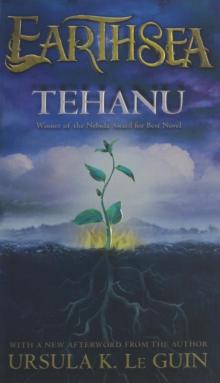 Tehanu
Tehanu The Tombs of Atuan
The Tombs of Atuan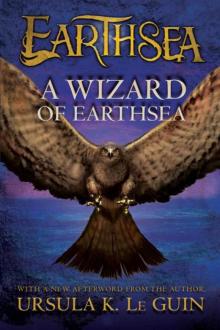 A Wizard of Earthsea
A Wizard of Earthsea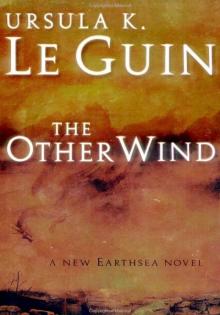 The Other Wind
The Other Wind Ursula K. Le Guin
Ursula K. Le Guin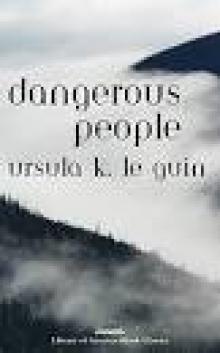 Dangerous People
Dangerous People Worlds of Exile and Illusion: Rocannon's World, Planet of Exile, City of Illusions
Worlds of Exile and Illusion: Rocannon's World, Planet of Exile, City of Illusions Three Hainish Novels
Three Hainish Novels The Left Hand Of Darkness (SF Masterworks)
The Left Hand Of Darkness (SF Masterworks) The Unreal and the Real - Vol 1 - Where On Earth
The Unreal and the Real - Vol 1 - Where On Earth The Visionary
The Visionary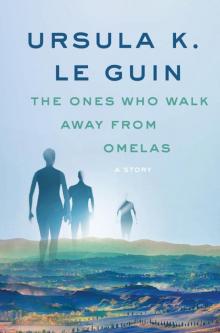 The Ones Who Walk Away from Omelas
The Ones Who Walk Away from Omelas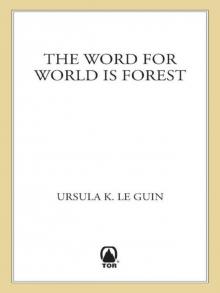 The Word for World is Forest
The Word for World is Forest Always Coming Home
Always Coming Home The Unreal and the Real - Vol 2 - Outer Space, Inner Lands
The Unreal and the Real - Vol 2 - Outer Space, Inner Lands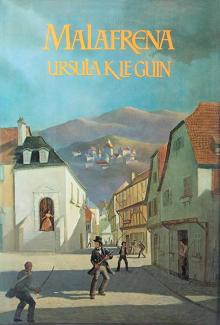 Malafrena
Malafrena The Lathe of Heaven
The Lathe of Heaven Five Ways to Forgiveness
Five Ways to Forgiveness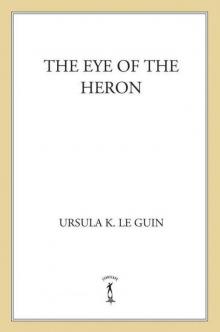 The Eye of the Heron
The Eye of the Heron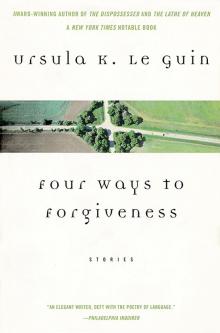 Four Ways to Forgiveness
Four Ways to Forgiveness Powers
Powers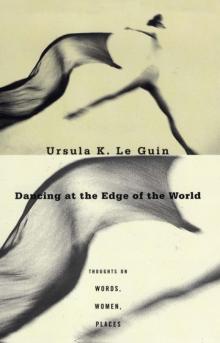 Dancing at the Edge of the World
Dancing at the Edge of the World Very Far Away from Anywhere Else
Very Far Away from Anywhere Else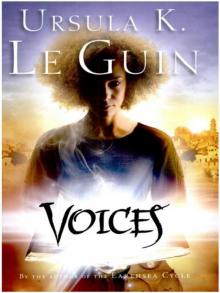 Voices aotws-2
Voices aotws-2 The New Atlantis
The New Atlantis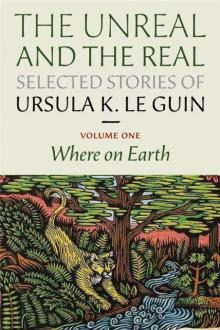 The Unreal and the Real, Selected Stories of Ursula K. Le Guin Volume 1: Where on Earth
The Unreal and the Real, Selected Stories of Ursula K. Le Guin Volume 1: Where on Earth The Telling
The Telling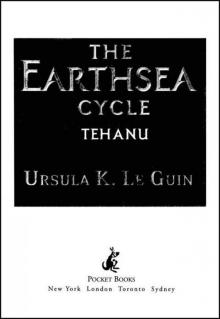 Tehanu (Earthsea Cycle)
Tehanu (Earthsea Cycle) Nine Lives twtq-9
Nine Lives twtq-9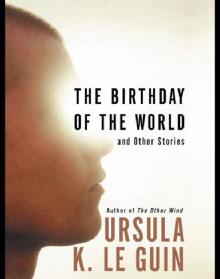 The Birthday of the World and Other Stories
The Birthday of the World and Other Stories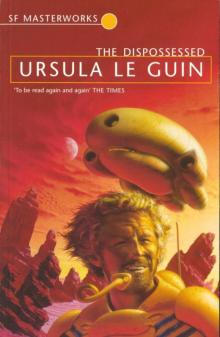 The Dispossessed
The Dispossessed Changing Planes
Changing Planes Words Are My Matter
Words Are My Matter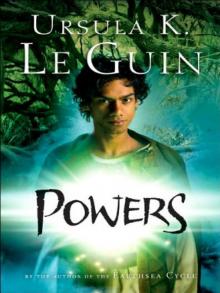 Powers aotws-3
Powers aotws-3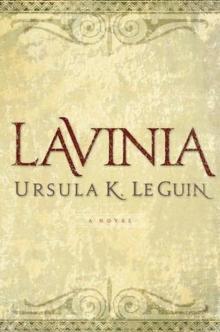 Lavinia
Lavinia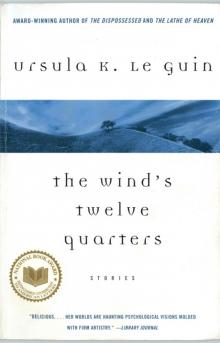 The Wind's Twelve Quarters
The Wind's Twelve Quarters Orsinian Tales
Orsinian Tales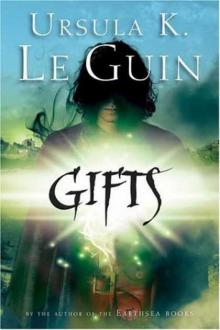 Gifts aotws-1
Gifts aotws-1 Coming of Age in Karhide
Coming of Age in Karhide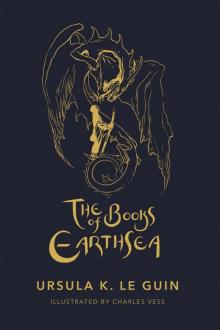 The Books of Earthsea: The Complete Illustrated Edition
The Books of Earthsea: The Complete Illustrated Edition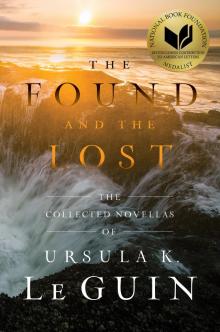 The Found and the Lost
The Found and the Lost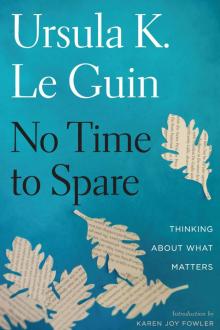 No Time to Spare
No Time to Spare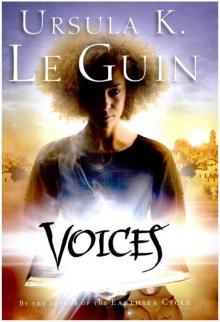 Voices
Voices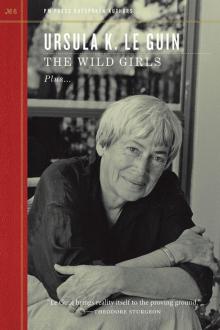 The Wild Girls
The Wild Girls Old Music and the Slave Women
Old Music and the Slave Women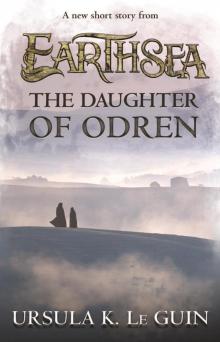 The Daughter of Odren
The Daughter of Odren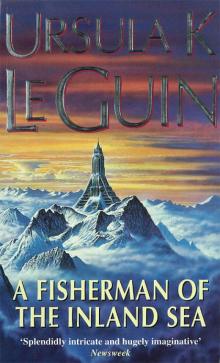 A Fisherman of the Inland Sea: Stories
A Fisherman of the Inland Sea: Stories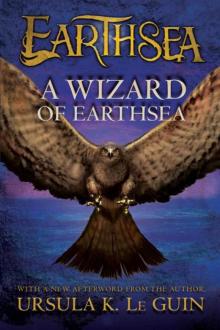 A Wizard of Earthsea (The Earthsea Cycle)
A Wizard of Earthsea (The Earthsea Cycle)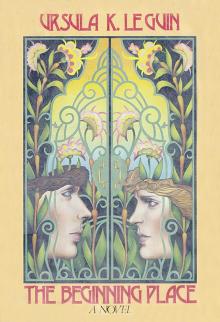 The Beginning Place
The Beginning Place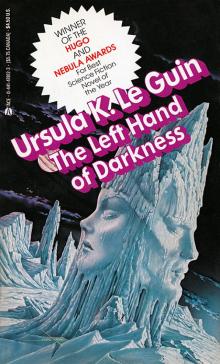 The Left Hand of Darkness
The Left Hand of Darkness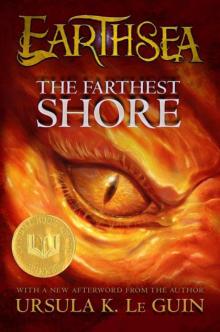 The Farthest Shore (Earthsea Cycle)
The Farthest Shore (Earthsea Cycle) The Matter of Seggri botw-2
The Matter of Seggri botw-2